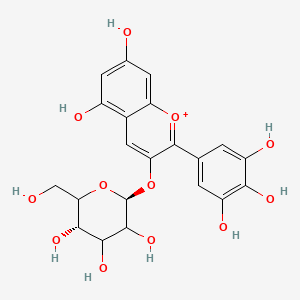| MeSH term | MeSH ID | Detail |
|---|---|---|
| Thrombosis | D013927 | 49 associated lipids |
Delphinidin 3-O-beta-D-glucopyranoside
Myrtillin is a lipid of Polyketides (PK) class. Myrtillin is associated with abnormalities such as abnormal fragmented structure. The involved functions are known as Methylation, Pigment and Energy Absorption. Myrtillin often locates in Body tissue.
Cross Reference
Introduction
To understand associated biological information of Delphinidin 3-O-beta-D-glucopyranoside, we collected biological information of abnormalities, associated pathways, cellular/molecular locations, biological functions, related genes/proteins, lipids and common seen animal/experimental models with organized paragraphs from literatures.
What diseases are associated with Delphinidin 3-O-beta-D-glucopyranoside?
Delphinidin 3-O-beta-D-glucopyranoside is suspected in and other diseases in descending order of the highest number of associated sentences.
Related references are mostly published in these journals:
| Disease | Cross reference | Weighted score | Related literature |
|---|
Possible diseases from mapped MeSH terms on references
We collected disease MeSH terms mapped to the references associated with Delphinidin 3-O-beta-D-glucopyranoside
PubChem Associated disorders and diseases
What pathways are associated with Delphinidin 3-O-beta-D-glucopyranoside
There are no associated biomedical information in the current reference collection.
PubChem Biomolecular Interactions and Pathways
Link to PubChem Biomolecular Interactions and PathwaysWhat cellular locations are associated with Delphinidin 3-O-beta-D-glucopyranoside?
Visualization in cellular structure
Associated locations are in red color. Not associated locations are in black.
Related references are published most in these journals:
| Location | Cross reference | Weighted score | Related literatures |
|---|
What functions are associated with Delphinidin 3-O-beta-D-glucopyranoside?
Related references are published most in these journals:
| Function | Cross reference | Weighted score | Related literatures |
|---|
What lipids are associated with Delphinidin 3-O-beta-D-glucopyranoside?
There are no associated biomedical information in the current reference collection.
What genes are associated with Delphinidin 3-O-beta-D-glucopyranoside?
There are no associated biomedical information in the current reference collection.
What common seen animal models are associated with Delphinidin 3-O-beta-D-glucopyranoside?
There are no associated biomedical information in the current reference collection.
NCBI Entrez Crosslinks
All references with Delphinidin 3-O-beta-D-glucopyranoside
Download all related citations| Authors | Title | Published | Journal | PubMed Link |
|---|---|---|---|---|
| pmid: | ||||
| Paixão J et al. | Dietary anthocyanins protect endothelial cells against peroxynitrite-induced mitochondrial apoptosis pathway and Bax nuclear translocation: an in vitro approach. | 2011 | Apoptosis | pmid:21785847 |
| Ichiyanagi T et al. | Absorption and metabolism of delphinidin 3-O-beta-D-glucoside in rats. | 2004 | Biofactors | pmid:15630238 |
| Schreiber HD et al. | Role of aluminum in red-to-blue color changes in Hydrangea macrophylla sepals. | 2011 | Biometals | pmid:21584711 |
| Yang X et al. | Delphinidin-3-glucoside suppresses breast carcinogenesis by inactivating the Akt/HOTAIR signaling pathway. | 2016 | BMC Cancer | pmid:27388461 |
| Paixão J et al. | Malvidin-3-glucoside protects endothelial cells up-regulating endothelial NO synthase and inhibiting peroxynitrite-induced NF-kB activation. | 2012 | Chem. Biol. Interact. | pmid:22959858 |
| Skemiene K et al. | Anthocyanins as substrates for mitochondrial complex I - protective effect against heart ischemic injury. | 2015 | FEBS J. | pmid:25586661 |
| Jing P et al. | Effect of glycosylation patterns of Chinese eggplant anthocyanins and other derivatives on antioxidant effectiveness in human colon cell lines. | 2015 | Food Chem | pmid:25442541 |
| He B et al. | Optimization of Ultrasound-Assisted Extraction of phenolic compounds and anthocyanins from blueberry (Vaccinium ashei) wine pomace. | 2016 | Food Chem | pmid:26988477 |
| Mazewski C et al. | Comparison of the effect of chemical composition of anthocyanin-rich plant extracts on colon cancer cell proliferation and their potential mechanism of action using in vitro, in silico, and biochemical assays. | 2018 | Food Chem | pmid:29037704 |
